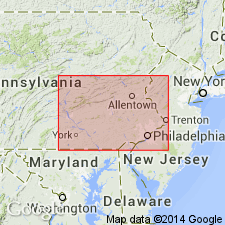
- Usage in publication:
-
- Pickering gneiss*
- Modifications:
-
- First used
- Dominant lithology:
-
- Gneiss
- AAPG geologic province:
-
- Piedmont-Blue Ridge province
Summary:
Name Pickering gneiss introduced here for graphitic gneisses in Chester Co., PA. Name credited to Florence Bascom who intends to separate out the graphitic gneisses from the nongraphitic gneisses, both of which she included in Baltimore gneiss in the Trenton folio.
Source: GNU records (USGS DDS-6; Reston GNULEX).
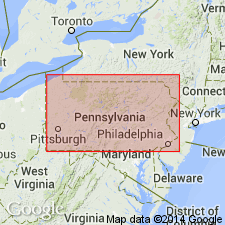
- Usage in publication:
-
- Pickering gneiss*
- Modifications:
-
- Overview
- AAPG geologic province:
-
- Piedmont-Blue Ridge province
Summary:
Observations at several places in Piedmont Plateau lead writer to believe Franklin limestone and Pickering gneiss constitute a single formation similar to Grenville formation of NY and CAN. The Franklin limestone or marble is coarsely crystalline, white, with graphite and numerous silicate minerals. The Pickering gneiss is banded gneiss or schist containing lenses of highly graphitic schists.
Source: GNU records (USGS DDS-6; Reston GNULEX).
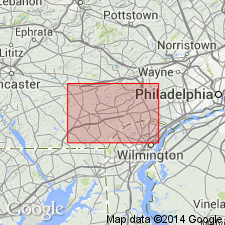
- Usage in publication:
-
- Pickering gneiss
- Modifications:
-
- Not used
- AAPG geologic province:
-
- Piedmont-Blue Ridge province
Summary:
Several years ago the writer, in mapping the rocks of Phoenixville quad., PA, separated the graphitic gneiss from the nongraphitic gneisses and proposed to apply to them the geographic name "Pickering gneiss," restricting the name Baltimore gneiss to the nongraphitic rocks, and that name and definition were published in an article by B.L. Miller (1912). More recent work, however, on the Precambrian gneisses of southeastern PA and DE has led writer to consider the graphitic gneiss associated with recognized Baltimore gneiss as essentially a facies of that formation and not a distinct formation. In this folio and other reports in preparation, therefore, the graphitic gneiss is included in the Baltimore gneiss and the name "Pickering gneiss" is dropped.
Source: GNU records (USGS DDS-6; Reston GNULEX).

- Usage in publication:
-
- Pickering gneiss*
- Modifications:
-
- Overview
- AAPG geologic province:
-
- Piedmont-Blue Ridge province
Summary:
In 1934, the USGS decided to adopt Pickering gneiss for the Precambrian sedimentary rocks associated with Franklin limestone --a white, coarsely crystalline limestone or marble, more or less contemporary with Pickering gneiss, with which it is found interbedded as well as apparently overlying. This gneiss is a medium-grained quartz-feldspar-mica rock, usually light-colored, owing to paucity of dark-colored constituents, and pinkish or greenish in tone, owing to abundant altered feldspar. The rock is always gneissic, but in absence of contrasting constituents this texture in not conspicuous. The feldspar is orthoclase, microperthite, microcline, and a sodic plagioclase, albite, or andesine. Graphite-bearing beds are an important feature of the formation in Phoenixville and Honeybrook quads. Unconformably underlies Lower Cambrian. Thickness unknown. Named for fact that Pickering Creek, Chester Co., lies almost wholly within the gneiss area. This is definition now followed by F. Bascom.
Source: GNU records (USGS DDS-6; Reston GNULEX).
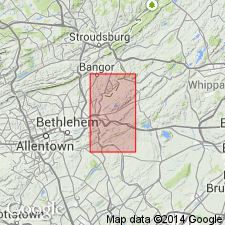
- Usage in publication:
-
- Pickering gneiss*
- Modifications:
-
- Revised
- AAPG geologic province:
-
- Piedmont-Blue Ridge province
Summary:
In the Highlands of report area, there is a series of schists and gneisses that are different from predominating gneisses of the district and that at many places are evidently closely associated with the Franklin limestone and at some places apparently grade into the limestone. They are regarded as sedimentary. Their relations to Pochuck, Byram, and Losee gneisses are not clear, but, because the Pochuck, Byram, and Losee are believed to be intrusive in the limestone, it is inferred that they are also intrusive in sedimentary gneisses and schists associated with the limestone. The sedimentary schists, slaty rocks, and gneisses are here included under the name Pickering gneiss, and the Pochuck gneiss to which they have previously been assigned is restricted to the black gneisses of igneous origin that are intrusive in the Franklin limestone and the sedimentary gneisses and schists.
Source: GNU records (USGS DDS-6; Reston GNULEX).
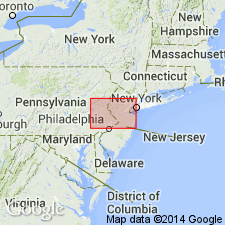
- Usage in publication:
-
- Pickering Gneiss*
- Modifications:
-
- Age modified
- AAPG geologic province:
-
- Piedmont-Blue Ridge province
Summary:
Age of the Pickering is modified to Middle Proterozoic.
Source: GNU records (USGS DDS-6; Reston GNULEX).
For more information, please contact Nancy Stamm, Geologic Names Committee Secretary.
Asterisk (*) indicates published by U.S. Geological Survey authors.
"No current usage" (†) implies that a name has been abandoned or has fallen into disuse. Former usage and, if known, replacement name given in parentheses ( ).
Slash (/) indicates name conflicts with nomenclatural guidelines (CSN, 1933; ACSN, 1961, 1970; NACSN, 1983, 2005, 2021). May be explained within brackets ([ ]).

